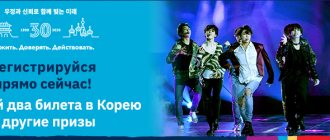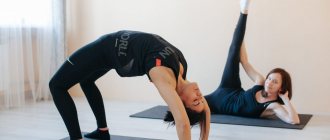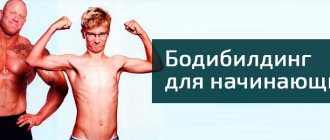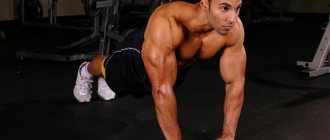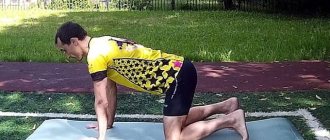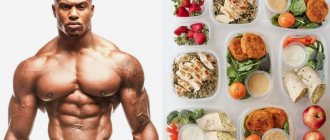Bodybuilding is of interest not only to young people, but also to those who have celebrated their significant half-century anniversary. Of course, going to the gym is beneficial for everyone, but As you age, you need to pay much more attention to your health.
In order to preserve and maintain oneself in excellent physical shape, strengthen the body, increase tone, but at the same time not harm health at all, people after fifty years of age need a special technique . If you follow the tips and recommendations below, listen to the needs of your own body, making certain adjustments to your sports program, each visit to the gym will bring maximum benefit.
Basic principles of a training program after 50 years
Age is not a hindrance to either sports or bodybuilding. Despite this fact, we must not forget that processes begin to occur in the body that affect the human condition in a far from positive way. These changes, unfortunately, cannot be stopped. They must be taken for granted and taken into account when creating a training program.
Degenerative changes begin to occur in the tissues of the joints, the speed of all regenerative processes decreases, the function of the endocrine system is disrupted, metabolism slows down, and so on. The body as a whole begins to work much worse than before. And you should never forget about this.
If the decision to take up bodybuilding is made in old age, then the training program should be developed taking into account all the fundamental principles for building the training process:
Frequency of loads - heavy training should be replaced by unloading
The concept of “heavy training” for an older athlete is strikingly different from a similar complex for young athletes. The number of repetitions when working with heavy weights should vary from 5 to 12, and with light ones - from 12 to 20. This load is enough to stop the catabolic reactions occurring in the muscles and gain a small amount of mass. In old age, there is no talk of increasing muscle mass.
Load control - the level should be selected as optimal as possible
Training will bring maximum benefit only if each exercise is performed correctly from a technical point of view, and the weight is selected correctly. In old age, joint mobility decreases significantly, so the range of motion should be somewhat different. Breathing deserves close attention.
Restoration of the body - rationally organized periods of rest
Metabolic rate decreases with age. This also applies to the production of hormones. Recovery processes are much slower, and, therefore, more time needs to be spent on rest. If you do not experience increased fatigue and ailments, a two-day break between training days is quite enough.
Nutrition - a properly selected and balanced diet
This point is no less important. You should not neglect your own health for the sake of sports results. The diet must fully comply not only with the basics of proper sports nutrition, but also be selected in full accordance with the age and needs of the body.
Nutrition for bedridden patients through a tube
Delivery of protein nutrition to a bedridden patient through a tube is preferable than through a dropper, and here’s why: deprived of work, the mucous membranes of the gastrointestinal tract gradually atrophy and lose their ability to function.
The consequences of atrophy are serious - the mucous membranes stick together, then grow together, and such pathology cannot always be eliminated even with the help of operations.
Situations in which full-fledged tube feeding is performed:
- when patients have extensive burns on the face;
- after extensive intestinal resection, when a large amount of tissue is removed (90% or more);
- if bedridden patients of corpulent constitution have not taken food for 7–10 days;
- when patients are malnourished and have not eaten well for the past 5 days;
- if patients are unconscious;
- after a stroke;
- in the presence of injuries to the larynx and esophagus;
- after undergoing surgery on the gastrointestinal tract.
To supply protein nutrition through a tube, you need:
- probe with a diameter of no more than 8 mm;
- a syringe through which food will be administered;
- food, chopped as much as possible.
All necessary items for tube feeding are thoroughly sterilized. Marks are placed along the entire length of the probe, which will indicate how deeply it was inserted into the body of the bedridden patient. Having passed 30–35 cm, the probe enters the stomach, 40–45 cm – into the intestine, and at a depth of 50–55 cm, the probe enters the duodenum.
When installing a tube into the patient’s body, you need to make sure that it goes into the esophagus and not into the respiratory tract. To facilitate insertion, the probe is thoroughly lubricated with glycerin and pulled through the nasopharynx.
After the probe has entered 15 cm, the patient must be seated as far as possible and the tube must be found in the mouth by touch. The probe is pressed to the back wall of the pharynx and inserted deeper. In this way, it is directed into the esophagus, through which it will definitely enter the gastrointestinal tract.
Only an appropriately trained specialist should insert a probe into the gastrointestinal tract. To understand whether the tube was inserted correctly, do the following: a Janet syringe with the piston pulled out is attached to the probe; A phonendoscope is applied to the area where the xiphoid process is located.
When air comes out of the syringe when pressed sharply, a sound similar to a splash appears in the phonendoscope. This means the installation was successful and food can be introduced.
Food should be crushed and warm. A small amount of food is drawn into the syringe, it is attached to the probe, and the infusion slowly begins. No more than one sip is given at a time. The nutrient solution must be introduced very slowly.
At the end of feeding, the syringe is disconnected from the probe, and the tube itself remains in the body of the bedridden patient with the free end fixed to the head until the patient recovers enough to eat on his own.
If a bedridden patient receives feeding through a tube, it is important to maintain sterility and feeding rules.
Otherwise, negative health consequences are inevitable.
We recommend
“Exercise machines for the elderly: types, advantages, main characteristics” Read more
Cardio and strength training for adult athletes
A guide to bodybuilding after 50 cannot be considered complete if it does not contain any practical recommendations. To have a clear idea of what direction to move in, you need to know everything about organizing cardio and strength training.
Cardio loads
Elderly athletes need to take special care of the condition of the vascular system and heart muscle, which are most often associated with most of the problems and ailments that appear with age. Cardio training is a kind of “lifeline” that allows you to maintain the function of the cardiovascular system at a fairly good level.
General recommendations
Moderate-intensity cardio should be done four times a week. The recommended duration of the lesson is at least thirty minutes, and the load should not be too high.
The main thing, first of all, is to decide on the intensity of the training. A small test that involves trying to speak allows you to do this. If the athlete can continue to communicate without any difficulty during training, you can safely continue training in this mode.
Cardio workout program
You can run, swim, ride a bike. There are no restrictions. The only recommendation is that you should not limit yourself to one type of cardio exercise. It is better to give preference to a variety of workouts, that is, alternate, for example, running with swimming and so on. It’s even more interesting and exciting to practice not alone, but with friends or relatives.
Drugs: “Time to take the pills”!
What are the limitations of age-related bodybuilding? Lower levels of growth hormone, testosterone, insulin and other hormones. To partially neutralize all this, we will need the following supplements: complex vitamins, OMEGA-3, vitamin E, B vitamins. These drugs should be taken in courses 3-4 times a year, which will significantly improve the level of health and, as a result, improve progress in bodybuilding. We also recommend that you add jelly to your diet, the same one that you once ate in childhood, since gelatin contains a lot of collagen, and collagen significantly improves the condition of ligaments and joints. If you have problems with digestion, and this happens often, then you should not take pills at random, go to the doctor, get tested and take what he prescribes for you!
Three sports nutrition products can help you: tribulus, BCAA and creatine . They say that protein, which is made from whey, although it does not promote muscle growth, can nevertheless be useful for those who suffer from constipation. So, if you like to sit on the toilet, run to a sports nutrition store. If not, then take your time! Creatine and tribulus should not be taken immediately and should be taken in courses, no more than 3-4 times a year, the duration of the course is 1 month. BCAA is the only supplement that we would recommend purchasing and taking on a regular basis, since branched chain amino acids are found in a very limited amount of foods and may not be fully absorbed, and BCAA will help offset this sad fact, which can negatively affect your progress .
Useful materials
Strength training
Athletes of any age very often neglect warming up. Every strength training session should begin with it, and should be performed twice a week. The total duration of each lesson can vary from twenty to forty minutes. The intensity should be chosen moderate. The main thing is that the training corresponds to the age of the athlete.
General recommendations
Strength training for athletes over 50 years of age has slightly different goals than similar exercises for young bodybuilders. Increasing physical parameters and gaining weight are no longer a priority. The main goal is to maintain muscle tone and improve health. There is no need to focus on working with free weights.
Strength training program
It is recommended to work on safe exercise machines, and not with weights. The intensity is assumed to be such that two to three sets of 8-12 repetitions are performed for each muscle group. The training should include functional movements that mimic those performed in everyday life.
List of Recommended Supplements
Microelements
The body always needs minerals and vitamins. The only difference is that as a person ages, he begins to consume much smaller amounts of nutrients. And if mineral supplements may be sufficient for everyday life, then against the background of bodybuilding, the likelihood of developing a deficiency of minerals and vitamins required for the normal functioning of the body increases. To compensate for this deficiency, you should take good, high-quality multivitamin complexes.
Fish fat
Unsaturated fatty acids are of great importance for older people. They are an integral part of metabolic processes and increase the performance of the joint-ligamentous apparatus. A deficiency of unsaturated fatty acids can trigger the development of many diseases, especially in older people. Taking fish oil can help avoid this.
Improving the functioning of the articular-ligamentous apparatus
The risk of dysfunction of joints and ligaments becomes more pronounced with age. Their normal function can be maintained by taking appropriate sports supplements.
Proteins and amines
Catabolic processes leading to the destruction of muscles occur when a person does not exercise. This phenomenon is typical for absolutely any age, but is much more pronounced after 50. Leading an active lifestyle resists these processes, but without the use of protein and amino acid supplements it is not as effective.
Organization of recreation in age bodybuilding
It should be said right away that before starting sports you should give up cigarettes and alcohol.
These bad habits greatly slow down the recovery process, which should not be allowed. For high-quality and quick recovery after training sessions, you need to speed up your metabolism. It is important to devote the necessary amount of time to sleep. This will probably be difficult at first, but you should strive for it. Also, to improve your sleep pattern after a training session in the evening, you should use calm walking for half an hour during your cool-down. It will be very good if you can find time to visit the massage room and bathhouse. All this also promotes recovery and increases metabolism.
You can learn more about age-related bodybuilding from this video:

